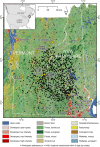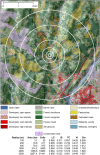Greenspace and Land Cover Diversity During Pregnancy in a Rural Region, and Associations With Birth Outcomes
- PMID: 38264534
- PMCID: PMC10804422
- DOI: 10.1029/2023GH000905
Greenspace and Land Cover Diversity During Pregnancy in a Rural Region, and Associations With Birth Outcomes
Abstract
Beneficial effects on health outcomes have been observed from exposure to spaces with substantial green vegetation ("greenspace"). This includes studies of greenspace exposure on birth outcomes; however, these have been conducted largely in urban regions. We characterized residential exposure to greenspace and land cover diversity during pregnancy in rural northern New England, USA, investigating whether variation in greenspace or diversity related to newborn outcomes. Five landscape variables (greenspace land cover, land cover diversity, impervious surface area, tree canopy cover, and the Normalized Difference Vegetation Index) were aggregated within six circular zones of radii from 100 to 3,000 m around residential addresses, and distance to conservation land was measured, providing a total of 31 greenspace and diversity metrics. Four birth outcomes along with potentially confounding variables were obtained from 1,440 participants in the New Hampshire Birth Cohort Study. Higher greenspace land cover up to 3,000 m was associated with larger newborn head circumference, while impervious surface area (non-greenspace) had the opposite association. Further, birth length was positively associated with land cover diversity. These findings support beneficial health impacts of greenspace exposure observed in urban regions for certain health outcomes, such as newborn head circumference and length but not others such as birthweight and gestational age. Further our results indicate that larger radius buffer zones may be needed to characterize the rural landscape. Vegetation indices may not be interchangeable with other greenspace metrics such as land cover and impervious surface area in rural landscapes.
© 2024 The Authors. GeoHealth published by Wiley Periodicals LLC on behalf of American Geophysical Union.
Conflict of interest statement
The authors declare no conflicts of interest relevant to this study.
Figures



Similar articles
-
Assessing associations between residential proximity to greenspace and birth defects in the National Birth Defects Prevention Study.Environ Res. 2023 Jan 1;216(Pt 3):114760. doi: 10.1016/j.envres.2022.114760. Epub 2022 Nov 7. Environ Res. 2023. PMID: 36356662 Free PMC article.
-
Association of exposure to air pollution and green space with ovarian reserve hormones levels.Environ Res. 2020 May;184:109342. doi: 10.1016/j.envres.2020.109342. Epub 2020 Mar 3. Environ Res. 2020. PMID: 32172073
-
The influence of early-life residential exposure to different vegetation types and paved surfaces on early childhood development: A population-based birth cohort study.Environ Int. 2022 May;163:107196. doi: 10.1016/j.envint.2022.107196. Epub 2022 Mar 23. Environ Int. 2022. PMID: 35339041
-
Exposure to urban greenspace and pathways to respiratory health: An exploratory systematic review.Sci Total Environ. 2022 Jul 10;829:154447. doi: 10.1016/j.scitotenv.2022.154447. Epub 2022 Mar 11. Sci Total Environ. 2022. PMID: 35283125
-
Spatiotemporal Variability of Urban Greenspace and Surface Temperature in Dhaka City: A Public Health Aspect.2023 Jul 1. In: Biloria N, Sebag G, Robertson H, editors. The Empathic City: An Urban Health and Wellbeing Perspective [Internet]. Cham (CH): Springer; 2023. Chapter 7. 2023 Jul 1. In: Biloria N, Sebag G, Robertson H, editors. The Empathic City: An Urban Health and Wellbeing Perspective [Internet]. Cham (CH): Springer; 2023. Chapter 7. PMID: 38091465 Free Books & Documents. Review.
Cited by
-
The land cover paradox: Characteristics of blue- and green spaces within and beyond high-risk suicide clusters.SSM Popul Health. 2025 May 22;31:101820. doi: 10.1016/j.ssmph.2025.101820. eCollection 2025 Sep. SSM Popul Health. 2025. PMID: 40530002 Free PMC article.
-
Measuring Greenspace in Rural Areas for Studies of Birth Outcomes: A Comparison of Street View Data and Satellite Data.Geohealth. 2024 Mar 28;8(4):e2024GH001012. doi: 10.1029/2024GH001012. eCollection 2024 Apr. Geohealth. 2024. PMID: 38560559 Free PMC article.
-
Causal evidence of the association between green and blue spaces (GBS) and maternal and neonatal health: a systematic review and meta-analysis protocol.BMJ Open. 2024 Aug 7;14(8):e082413. doi: 10.1136/bmjopen-2023-082413. BMJ Open. 2024. PMID: 39117403 Free PMC article.
References
-
- Benjamini, Y. , & Hochberg, Y. (1995). Controlling the false discovery rate: A practical and powerful approach to multiple testing. Journal of the Royal statistical society: Series B (Methodological), 57(1), 289–300. 10.1111/j.2517-6161.1995.tb02031.x - DOI
-
- Benjamini, Y. , & Yekutieli, D. (2001). The control of the false discovery rate in multiple testing under dependency. Annals of Statistics, 29(4), 1165–1188. 10.1214/aos/1013699998 - DOI
References From the Supporting Information
-
- Dobson, A. J. (1990). An introduction to generalized linear models. Chapman and Hall.
LinkOut - more resources
Full Text Sources
